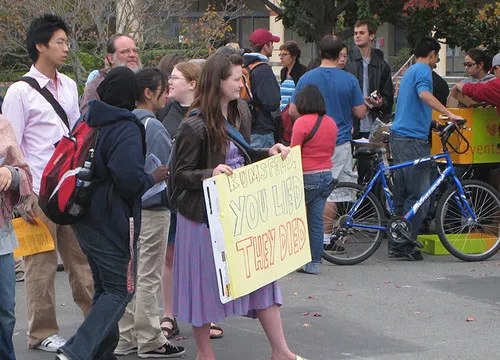Table of Contents
Today however, we observe a different phenomenon. Protesting has become a more thought out and organized activity, one that demands a certain amount of commitment and dedication, where supporters are taking a chance and students are standing out. Professors who would have once been eager to participate are now presented with an opportunity cost between focusing on attaining tenure or being noticeably politically active.
Growing competitiveness in the academic field, a shift in the political spectrum and continued political unrest and frustrations has changed the climate on college campuses. Professors find themselves in a difficult position, balancing their 9-5 job and all other activities that demand their attention beyond the classroom. When we look back at the 1960s and 70s, the number of politically active professors aiding their students in protest movements was much more significant than it is today. In fact, this shift in activism has gone from significant to barely existent.
“Compared to before…the American political spectrum has moved towards the right,” described Clayborne Carson, professor of history from the Martin Luther King Jr. Research and Education Institute. This shift has changed the political climate on campus, where professors have become less outspoken and more reserved with regards to their activism and political boisterousness.
Professors’ disappearance from campus marches and picketing can also be accounted for by the competitiveness of the academic field.
“As a professor, I have my hands full. I’m here to do research, I’m here to teach classes and compared with the professors of the 60s, more is asked of you,” Carson explained. Consequently, professors become more engrossed in their own academic pursuits, leaving their students to participate in the rallies that they had once attended in the 1960s.
However, the main question to ask is whether or not professors, regardless of their desire, have a place to be politically active on campus. Can the limits of their job go beyond the classroom, beyond lecture slides and office hours? Do we really want professors to express their personal beliefs and influence the student body?
Milton Achelpohl, a junior at Stanford University and an integral organizer of the Occupy Stanford movement explained that it is an “important role for professors and faculty to place themselves in the greater Stanford community and greater Stanford conversation.”
In fact, Julia A. Kennedy, a professor in the department of environmental earth system sciences has done just that. In an editorial Professor Kennedy wrote, she explained the need to mobilize faculty, staff, and undergraduates to create an Occupy the Future movement on Stanford’s campus to help shape the future of America through different community activities.
But how far should faculty be involved? At Stanford, students are being educated to think critically and contribute to society in an effective and innovative way. As such, professors should have a distinct place within our institution to teach and provide the different vantage points in their academic field, but to then let their students come to their own conclusions.
Students are impressionable and if professors were to teach in a very compelling manner their own personal viewpoints, the risk of having intellectually cloned students would increase. We want to be able to create a diverse body of opinions on campus, ones that are intriguing and novel with the potential to change the political climate on campus and potentially of the nation as a whole. If professors divulge one-sided opinions in the fields of social science, philosophy and literature, students are more prone to duplicating these ideas rather than creatively coming up with new ones. The value of professors then diminishes if all they do is parrot their opinions and detract from intellectual stimulation.
Moreover, there may be better outlets for professors to express their impassioned views: their own research and published articles. In fact, if students have the desire to know their lecturers views outside the classroom, the material is widely available. Perhaps time, resources and knowledge would be more efficiently put to use if professors directed their desire to be politically active in the materials they published. Indeed, professors are allotted a great deal of time to this activity and would more efficiently contribute to intellectual diversity and development if they focused their energy on something they are paid to do, rather than participating in rallies and chants. Professors must urge students from a teaching perspective to make a difference, but their own time to go out and picket has passed.
Professor Carson described that, due to student activism, “professors who might be silently sympathetic are kind of drawn into the fray”. This is probably the best balance that can be reached. Students who find themselves motivated to stand up for a certain cause and be politically active on campus can reach out to professors and draw them in at their own whims and desires. But professors must be able to distinguish the enrichment they provide to students in the classroom and the excessive influence they may be pushing upon students in personally motivated campus activism.





